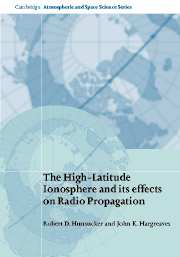Book contents
- Frontmatter
- Contents
- From the Times of London
- Preface
- Chapter 1 Basic principles of the ionosphere
- Chapter 2 Geophysical phenomena influencing the high-latitude ionosphere
- Chapter 3 Fundamentals of terrestrial radio propagation
- Chapter 4 Radio techniques for probing the ionosphere
- Chapter 5 The high-latitude F region and the trough
- Chapter 6 The aurora, the substorm, and the E region
- Chapter 7 The high-latitude D region
- Chapter 8 High-latitude radio propagation: part 1 – fundamentals and early results
- Chapter 9 High-latitude radio propagation: part 2 – modeling, prediction, and mitigation of problem
- Appendix: some books for general reading
- Index
Chapter 4 - Radio techniques for probing the ionosphere
Published online by Cambridge University Press: 02 December 2009
- Frontmatter
- Contents
- From the Times of London
- Preface
- Chapter 1 Basic principles of the ionosphere
- Chapter 2 Geophysical phenomena influencing the high-latitude ionosphere
- Chapter 3 Fundamentals of terrestrial radio propagation
- Chapter 4 Radio techniques for probing the ionosphere
- Chapter 5 The high-latitude F region and the trough
- Chapter 6 The aurora, the substorm, and the E region
- Chapter 7 The high-latitude D region
- Chapter 8 High-latitude radio propagation: part 1 – fundamentals and early results
- Chapter 9 High-latitude radio propagation: part 2 – modeling, prediction, and mitigation of problem
- Appendix: some books for general reading
- Index
Summary
Introduction
The purpose of this chapter is to review the basic techniques (and the newer modifications and adaptations of these techniques) for studying the terrestrial ionosphere, with particular emphasis on the capabilities and limitations of the techniques when they are used to probe the high-latitude ionosphere. We are fortunate to have several books and reports written since 1989 that have addressed the general topic of ionospheric investigations using radio techniques (Kelley, 1989; Liu, 1989; Davies, 1990; Hunsucker, 1991; Hargreaves, 1992; Hunsucker, 1993 and 1999; pp. 502–505), so in this chapter we will emphasize the limitations and capabilities of these techniques and update the information on deployment of ionospheric instrumentation at high latitudes. Figure 3.34 of Chapter 3 shows the frequency–height regimes which various selected radio techniques can probe.
Ground-based systems
Ionosondes
In its simplest form, an ionosonde consists of a transmitter and receiver with coupled tuning circuits, which is swept in frequency (usually in the frequency range of approximately 0.5–25 MHz). It can be either a pulsed or a CW-FM (chirp) system, and the transmitter and receiver can either be co-located (monostatic) or separated (bistatic). After the RF signals have been reflected by the ionosphere they are received and processed by the receiver to produce ionograms. The basic information in the received signal is the transit time for passage between ionospheric layers and the Earth, frequency, amplitude, phase, polarization, Doppler shift, and spectrum shape (see Section 3.2.4).
- Type
- Chapter
- Information
- Publisher: Cambridge University PressPrint publication year: 2002



